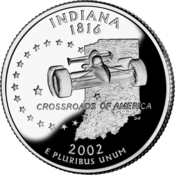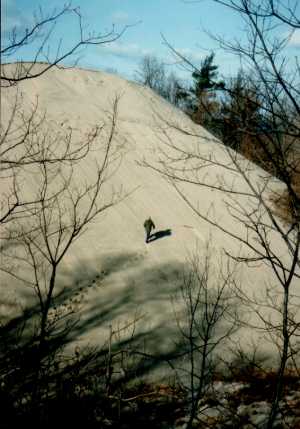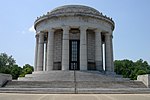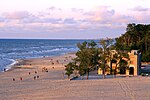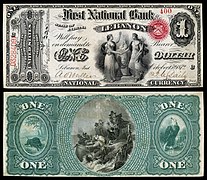The Indiana Portal
Various indigenous peoples inhabited what would become Indiana for thousands of years, some of whom the U.S. government expelled between 1800 and 1836. Indiana received its name because the state was largely possessed by native tribes even after it was granted statehood. Since then, settlement patterns in Indiana have reflected regional cultural segmentation present in the Eastern United States; the state's northernmost tier was settled primarily by people from New England and New York, Central Indiana by migrants from the Mid-Atlantic states and adjacent Ohio, and Southern Indiana by settlers from the Upland South, particularly Kentucky and Tennessee.
Indiana has a diverse economy with a gross state product of $352.62 billion in 2021. It has several metropolitan areas with populations greater than 100,000 and a number of smaller cities and towns. Indiana is home to professional sports teams, including the NFL's Indianapolis Colts and the NBA's Indiana Pacers. The state also hosts several notable competitive events, such as the Indianapolis 500, held at Indianapolis Motor Speedway. (Full article...)
Selected article -

Slavery in Indiana occurred between the time of French rule during the late seventeenth century and 1826, with a few traces of slavery afterward.
Opposition to slavery began to organize in Indiana around 1805, and in 1809 abolitionists took control of the territorial legislature and overturned many of the laws permitting retaining of slaves. By the time Indiana was granted statehood in 1816, the abolitionists were in firm control and slavery was banned in the constitution. In 1820, an Indiana Supreme Court ruling in Polly v. Lasselle freed Polly Strong and provided a precedent for other enslaved people. An additional Supreme Court ruling in 1821 freed indentured servant Mary Bateman Clark, helping to bring an end to indentured servitude. (Full article...)Selected image -
Did you know -
- ... that William N. Salin was twice decorated with the Sagamore of the Wabash?
- ... that the first studio of Indiana high school radio station WETL was a cedar closet that had once stored furs?
- ... that the 1938 film Road Demon contains footage of well-known accidents that occurred at Indianapolis Motor Speedway?
- ... that the 2020 case Henderson v. Box held that the state of Indiana must list same-sex parents on their child's birth certificate?
- ... that the veto of an Indiana law that bans transgender girls from participating in school sports was overridden by the state legislature?
- ... that an "army" of women were congratulated by Pat Nixon for their fundraising efforts to bring public TV to Indianapolis?
Related portals
Selected geographic article -
Lafayette (/ˌlɑːfiːˈɛt, ˌlæf-/ LAH-fee-ET, LAF-ee-ET) is a city in and is the county seat of Tippecanoe County, Indiana, United States, located 63 miles (101 km) northwest of Indianapolis and 125 miles (201 km) southeast of Chicago. According to the 2020 census, the population of Lafayette was 70,783. West Lafayette, on the other side of the Wabash River, is home to Purdue University, which contributes significantly to both communities. Together, they form the core of the Lafayette metropolitan area, which had a population of 235,066 in 2020.
Lafayette was founded in 1825 on the southeast bank of the Wabash River near where the river becomes impassable for riverboats upstream, though a French fort and trading post had existed since 1717 on the opposite bank and three miles downstream. It was named for the French general Marquis de Lafayette, a Revolutionary War hero. (Full article...)Selected biography -
John J. Mellencamp (born October 7, 1951), previously known as Johnny Cougar, John Cougar, and John Cougar Mellencamp, is an American singer-songwriter. He is known for his catchy brand of heartland rock, which emphasizes traditional instrumentation. He was inducted into the Rock and Roll Hall of Fame in 2008, followed by an induction into the Songwriters Hall of Fame in 2018.
Mellencamp rose to fame in the 1980s while "honing an almost startlingly plainspoken writing style" that, starting in 1982, yielded a string of Top 10 singles, including "Hurts So Good", "Jack & Diane", "Crumblin' Down", "Pink Houses", "Lonely Ol' Night", "Small Town", "R.O.C.K. in the U.S.A.", "Paper in Fire", and "Cherry Bomb". He has amassed 22 Top 40 hits in the United States. In addition, he holds the record for the most tracks by a solo artist to hit number one on the Hot Mainstream Rock Tracks chart, with seven. Mellencamp has been nominated for 13 Grammy Awards, winning one. He has sold over 30 million albums in the US and over 60 million worldwide. His latest album of original songs, Orpheus Descending, was released in June 2023. (Full article...)Selected quote
General images
Topics
- Economy: AM General - ATA Airlines - Casinos - Cummins - Delta - ITT - JayC - Lilly - Limestone - Manufacturing - NiSource - Shoe Carnival - Simon Property Group - Soybeans - Studebaker - Vectren - WellPoint
- Geography: Caves - Lakes - Rivers - State forests - Watersheds
Categories
Attractions
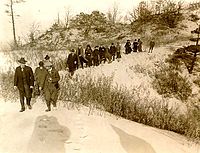 |
Recognized content
| This is a list of recognized content, updated weekly by JL-Bot (talk · contribs) (typically on Saturdays). There is no need to edit the list yourself. If an article is missing from the list, make sure it is tagged (e.g. {{WikiProject Indiana}}) or categorized correctly and wait for the next update. See WP:RECOG for configuration options. |
Good articles
- 1963 Indiana State Fairgrounds Coliseum gas explosion
- 2006 Brickyard 400
- 2011 South Bend mayoral election
- 2015 South Bend mayoral election
- 2019 South Bend mayoral election
- 2021 NCAA Division I men's basketball championship game
- Max Bielfeldt
- The Fault in Our Stars (film)
- Hurley Goodall
- Proposed South Shore Line station in South Bend
- WCAE
Featured pictures
-
Kenje Ogata 1943
-
Kurt Vonnegut by Bernard Gotfryd (1965)
-
US-NBN-IL-Lebanon-2057-Orig-1-400-C
WikiProjects
State facts
Indiana | |
|---|---|
| Country | United States |
| Admitted to the Union | December 11, 1816 (19th) |
| Capital | Indianapolis |
| Largest city | Indianapolis |
| Largest metro and urban areas | Indianapolis-Carmel MSA |
| Government | |
| • Governor | Eric Holcomb (R) (2017) |
| • Lieutenant Governor | Suzanne Crouch (R) (2017) |
| Legislature | Indiana General Assembly |
| • Upper house | Senate |
| • Lower house | House of Representatives |
| U.S. senators | Todd Young (R) Mike Braun (R) |
| Population | |
| • Total | 6,080,485 |
| • Density | 169.5/sq mi (65.46/km2) |
| Language | |
| • Official language | English |
| Latitude | 37° 46′ N to 41° 46′ N |
| Longitude | 84° 47′ W to 88° 6′ W |
Things you can do
 |
Here are some tasks awaiting attention:
|
Associated Wikimedia
The following Wikimedia Foundation sister projects provide more on this subject:
-
Commons
Free media repository -
Wikibooks
Free textbooks and manuals -
Wikidata
Free knowledge base -
Wikinews
Free-content news -
Wikiquote
Collection of quotations -
Wikisource
Free-content library -
Wikiversity
Free learning tools -
Wikivoyage
Free travel guide -
Wiktionary
Dictionary and thesaurus
- ^ a b "Elevations and Distances in the United States". U.S Geological Survey. 29 April 2005. Retrieved 2006-11-06.
